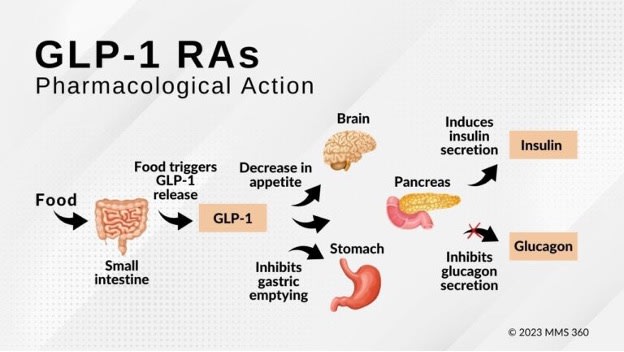Table of Contents
I. Rybelsus and Its Role in Diabetes Management
II. Managing Long-Term Side Effects of Rybelsus
III. The Importance of Personalized Treatment
Rybelsus (active ingredient semaglutide) is the first oral GLP-1 treatment for type 2 diabetes, marking a significant advancement in the treatment of the condition. Rybelsus offers the convenience of pill-form medication while maintaining its well-proven efficacy in lowering blood sugar levels. That said, as with the adoption of any long-term treatment regimen, understanding the long-term side effects of Rybelsus is critical to ensure its safe use.
Awareness of Rybelsus side effects helps patients identify and mitigate symptoms earlier, reducing their severity and improving treatment outcomes. In this article, we’ll specifically focus on the long-term side effects associated with Rybelsus and offer insight into how to manage them.
Exploring both the challenges and solutions gives Rybelsus the knowledge they need to navigate their treatment journey effectively, ensuring optimal diabetes management with minimal discomfort.
Quick Takeaways:
- Rybelsus is the first oral GLP-1 receptor agonist, making type 2 diabetes management easier for many patients.
- Awareness of potential long-term side effects of Rybelsus, such as GI issues and pancreatitis, is essential for early detection and symptom mitigation.
- Individual responses to Rybelsus vary, highlighting the need for personalized treatment plans tailored by healthcare providers.
- Regular follow-ups with healthcare providers and adjustments to treatment are key to safely maximizing Rybelsus's benefits for diabetes management.
Rybelsus and Its Role in Diabetes Management
Rybelsus is a GLP-1 receptor agonist that enhances the body's natural ability to regulate blood sugar levels by stimulating insulin release in response to elevated blood glucose. It also slows gastric emptying and suppresses appetite, contributing to weight management, a crucial aspect of type 2 diabetes care.

The introduction of Rybelsus has been a game-changer for many, providing a much-needed alternative to injectable diabetes medications. Its ease of use not only simplifies daily routines but also opens the door for better patient adherence to treatment plans, a crucial factor in long-term diabetes management.
But embracing Rybelsus as a long-term solution comes with its own set of considerations. While it brings undeniable benefits, understanding the potential long-term side effects is essential for anyone looking to incorporate Rybelsus into their diabetes treatment plan.
As we dive deeper into the role of Rybelsus in managing Type 2 diabetes, it's important to keep in mind that successful treatment requires balance. Monitoring for long-term side effects, in conjunction with regular consultations with healthcare providers, ensures that the journey with Rybelsus is as safe as it is effective.
Managing Long-Term Side Effects of Rybelsus
While there’s no doubt Rybelsus is convenient and effective, attention to its long-term side effects is essential for users. This section aims to explore these side effects more deeply, providing strategies for mitigation to ensure ongoing health and well-being.
Gastrointestinal Issues
Extended use of Rybelsus can lead to ongoing gastrointestinal disturbances, including nausea, vomiting, diarrhea, and constipation. These symptoms result from the drug's slowing of gastric emptying to regulate blood sugar levels. To manage these effects, patients are advised to eat smaller, more frequent meals, incorporate dietary fibers to ease constipation, and stay well-hydrated.
Pancreatitis
Rybelsus can increase the risk of pancreatitis, or a serious inflammation of the pancreas. Symptoms to watch for include persistent severe abdominal pain (that often radiates to the back), nausea, and vomiting. Immediate medical attention is crucial if these symptoms occur. Patients can reduce their risk by maintaining a low-fat diet, limiting alcohol consumption, and regularly monitoring blood triglyceride levels as advised by healthcare providers.
Thyroid Tumors
The potential risk of thyroid C-cell tumors, including medullary thyroid carcinoma (MTC), has been observed in rodent studies with GLP-1 receptor agonists. Though the relevance to humans is not fully determined, vigilance for symptoms such as neck swelling, difficulty swallowing, or persistent hoarseness is important. Regular thyroid examinations can aid in early detection and management of any abnormalities.
Hypoglycemia
Rybelsus can also increase the risk of hypoglycemia, especially when it’s combined with other diabetes medications. To mitigate this, patients should closely monitor their blood sugar levels, particularly when making any changes to their medication regimen or diet. Recognizing early signs of hypoglycemia, like dizziness, sweating, and hunger, and having quick-access glucose sources can prevent severe episodes.
Diabetic Retinopathy Complications
An increased incidence of diabetic retinopathy complications has been reported in some patients using Rybelsus. This underscores the need for regular comprehensive eye exams to monitor for any changes in vision or eye health. Maintaining stable blood glucose levels is also key to reducing this risk.
By understanding these long-term side effects and implementing strategies to mitigate them, patients can continue to utilize Rybelsus as a valuable tool in their diabetes management arsenal, ensuring they reap the benefits of treatment while minimizing potential risks.
Regular follow-ups with healthcare providers will enable personalized adjustments to treatment plans, enhancing safety and efficacy.
The Importance of Personalized Treatment
The journey with Rybelsus, as with any medication for a chronic condition, requires a personalized approach to treatment planning. Individual responses to Rybelsus can vary significantly due to differences in metabolism, underlying health conditions, and even lifestyle factors.
This variability means that while some may experience minimal side effects, others might encounter more pronounced issues requiring intervention. Healthcare providers play an important role in tailoring treatment plans to fit the unique needs and experiences of each patient.
By closely monitoring the effectiveness of Rybelsus and any side effects that arise, medical professionals can make informed decisions about dosage adjustments or the addition of complementary therapies.
This personalized approach not only optimizes the therapeutic benefits of Rybelsus but also minimizes the risk of adverse effects, ensuring that patients receive the most effective and comfortable treatment for their diabetes management.
For those taking Rybelsus as part of their diabetes treatment plan, My Drug Center offers a safe and affordable way to access your medication, with the added benefit of convenient home delivery. Learn more here about how to order your next prescription.
The information in the article is not meant to be used for treatment or diagnosis. It is designed for general awareness and for information purposes only. Always consult a medical professional for your specific healthcare needs.
